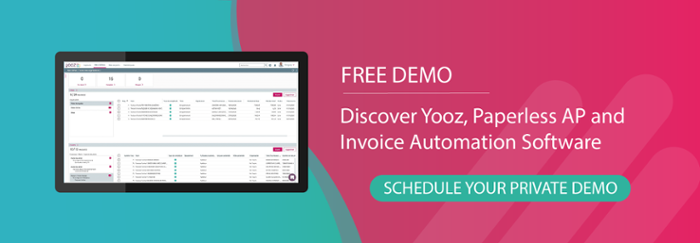“I thought I was good at my job!” mentioned a distressed Accounts Payable professional. “But the CFO is telling me that we pay too many bills late, our cost per invoice is too high, and we have the wrong mix of team members”.
Sadly, this concern about job performance is not unique. Nor is having a finance leader that is questioning the same for all the accounting systems and finance functions of their business. The questions are how do any of them know? How do you know?
The answer is to use Accounts Payable performance metrics.
The Institute of Finance and Management (IOFM) has conducted research for its three-year benchmarking series on this topic, with the 2019 Measuring Your AP Performance: Efficiency Benchmarks addressing various levels of concern. Let's review the four key metrics to help finance leaders manage Accounts Payable goals, especially when combined with accounts payable automation.
Four key metrics to help manage Accounts Payable
According to IOFM there are four metrics in particular to use as benchmarks for measuring Accounts Payable performance in your team and organisation. These are:
- Paid On-Time Rates
- Cost Per Invoice
- Number of Invoices Processed Per Full-Time Employee (FTE)
- Mix of Specialists vs. Managers on Your Team
Let’s dive a little deeper into what each of these important metrics mean and what finance leaders should look for along the way.
Metric 1: paid on time rates
If your AP department pays invoices by the due date over 90% of the time, then you are an Accounts Payable top performer. This 90%+ percentage is typical among departments that have an automated AP workflow. In comparison, those companies still working with manual invoice and payment processing are more likely to have paid on-time rates of around 75%.
Why is this important? Not only could late payments result in penalties and restricted cash flow, but you are also leaving money on the table by losing an opportunity to take advantage of any early pay discounts or benefits from your vendors.
Reduce late payments and start contributing to the bottom line!
Metric 2: cost per invoice
Much research has been done regarding the amount of money saved by using an automated AP process measured solely according to the difference in cost to manually process a single invoice versus the cost to digitally process the same invoice. According to the research presented in the IOFM Efficiency Benchmarks report referenced above this is in line with other industry benchmarks; “While the full cost per invoice includes employee benefits, one-time and ongoing automation costs, and other corporate overhead; it should also be an all-in number that includes procurement costs”.
The difference in processing costs is notable:
- If between £7-12 per invoice, you are probably still manually processing paper documents (time consuming, tedious, and error-prone work).
- For costs between £2.5-3 per invoice, you are in the digital age and have at least partially automated your invoice and payment processing.
That total potential savings of 9 x the number of invoices you process per year translates directly to the organisation's bottom line as well as could be going towards more beneficial things like research and new product development.
Metric 3: number of invoices processed per FTE
The least efficient Accounts Payable teams - the ones which work with little to no invoice and payment processing automation - can process only 10,700 per Full-Time Employee (FTE) per year on average. Compare this number with those AP teams who have an automated invoice and payment processing workflow and can process twice that amount.
Now imagine if the same number of FTEs could process twice the volume of invoices. That means as your company grows, and the number of documents increases, you could do more with the same headcount.
Even better, you will have the option of reallocating staff to more value-added activities such as improving supplier and vendor relationships or searching for alternative revenue opportunities like capturing early payment discounts.
Metric 4: mix of specialists vs. managers
Current benchmarks for low Accounts Payable automated companies suggest a greater ratio of lower-level Accounts Payable specialists to managers. And as the level of automation increases this ratio is reversed, having a higher number of upper managers compared to specialists.
According to IOFM’s benchmarking study, “this measure is not intended to be used as a tool for firing or demoting anyone to reset your staffing mix”. Rather, as you lose specialist-level staff to attrition, you might replace them with a higher-level manager position.
With invoice and payment process automation, you need fewer FTEs to manually enter data and track down approvals and more thought leaders to analyze the data and provide leaders throughout the organization with insight needed to make smarter, more strategic decisions.
The most efficient Accounts Payable processes are highly automated
What is a similar theme throughout all four key Accounts Payable performance metrics? The benefits of automation.
Findings indicate that when a business is highly automated with a real-time Accounts Payable automation solution like Yooz they are able to eliminate late payments and take advantage of early payment incentives, drastically reduce the amount of time required to process a single invoice, increase employee efficiency and engagement by freeing up time for more value-added tasks, and enable AP departments to have a higher ration of upper level managers versus mid to lower-level AP specialists. These are the types of accounts payable performance metrics that are straightforward Key Performance Indicators (KPIs), easy to measure, and pay off as a rule (not an exception).
Elevate Your Accounts Payable Performance Metrics with Yooz
Enhance your accounts payable performance metrics with Yooz, the leading AI-powered automation solution. With Yooz, you can automate 80% of invoices seamlessly, eliminating manual errors and streamlining your processes for maximum efficiency. Experience real-time AI performance coupled with unparalleled simplicity, enabling you to start optimizing your performance metrics within just one hour, without the need for extensive training. Yooz's all-in-one platform allows you to automate every step of your P2P process, from purchase request to payment, providing unrivaled business richness. Trusted by top accounting firms and recognized globally for its innovation, Yooz ensures that your accounts payable performance metrics reach new heights. Join the thousands of businesses worldwide who rely on Yooz to drive efficiency and accuracy in their accounts payable processes, and elevate your performance metrics today.








